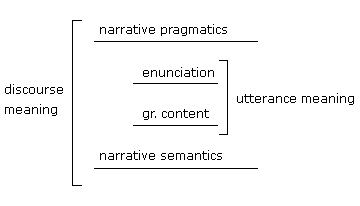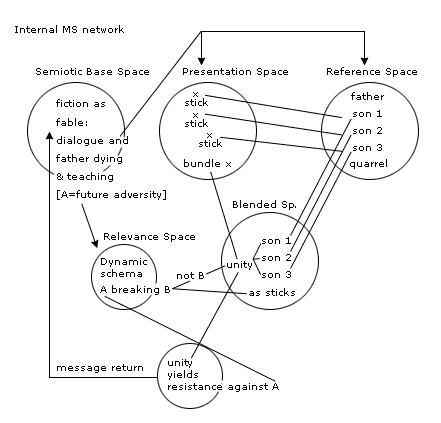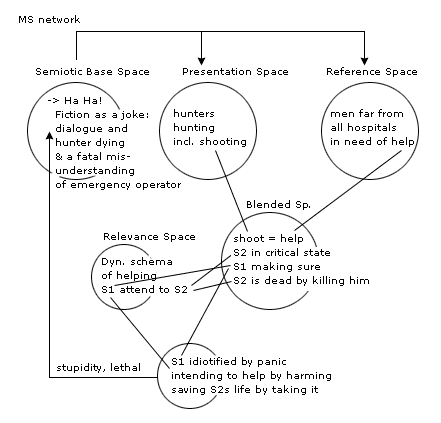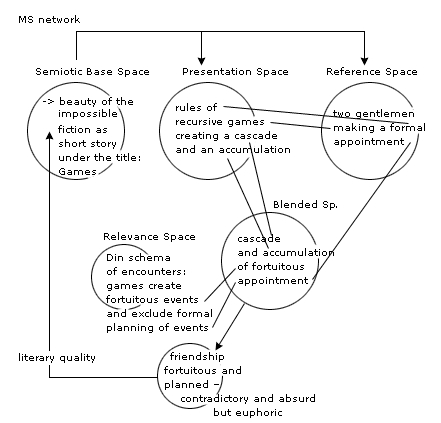|
Narrative sequencing of linguistic utterances is a basic dynamic principle of discourse. Other forms of sequencing include prescriptive, descriptive and argumentative concatenations of utterances; it has been suggested (e.g. by A.-J. Greimas) that prescriptions, descriptions and argumentations are always, explicitly or implicitly, framed by a narrative setting, either in an overarching discourse or in the very process of living experience. In explicitly narrative discourse, it is possible to stipulate a textual architecture in which some structures are local and others global. Local structures are utterance-based, whereas global structures are properly discursive. We may view the structural situation as follows:  The microstructures of enunciation[1] - the avatars of first-, second-, and third-person-hood in grammatical expressions of narrative, descriptive or argumentative contents - integrate into a macrostructure, namely a larger context of narrative pragmatics containing narratorial forms, speech acts, scenarios of communication: instances of "storytelling". Correspondingly, the microstructures of grammatical content integrate into a macrostructure of entire "stories told", organized by the narrative semantics of the human mind and the cultural circumstances that make stories both intelligible and plausible within specific discourse genres. The theoretical separation of narrative pragmatics and narrative semantics should make it possible to distinguish two major problems in narratology: 1) What is fiction?, and 2) What is a story? (1) refers to narrative pragmatics, and (2) refers to narrative semantics. It is possible to answer or develop either question separately. Let me briefly state that (cf. 1) fiction has to be of a certain genre, for example the genre called fable, or the genre called joke, just to stay in the realm of "simple forms", as André Jolles[2] has suggested. Genres in discourse are enunciation-based pragmatic designs equipped with functional performative determinations; and they are always correlated with certain content-based semantic designs. So, fables are expected to be didactic, and jokes are expected to be funny and to produce social relief of some sort. Within such genres, a fiction[3] achieves its format, its finite extension, thereby allowing listeners and readers to know when to stop waiting for more input and to start interpreting. Each genre thus develops its own narrative semantics (cf. 2) and a general outline of the specific event structures it will be likely to unfold. In a sense, its pragmatics 'drives' its semantics, as the following examples may show. Here is first a classical short didactic fable and an analytic sketch in terms of Mental Space Semiotics. Aesop: [4] The Bundle of Sticks An old farmer had three sons who quarreled among themselves from dawn to dusk. One day, the farmer fell gravely ill. Wishing to make peace among his sons before he died, he called them to his bedside and asked them to bring a thick bundle of sticks. "Can you break these in two?" asked the farmer, handling the sticks to his oldest son. "Of course!" the young man answered scornfully. But even though he tried until he was red in the face, he couldn't break the bundle of sticks. "Why, those sticks are no thicker than my finger," mocked the second son. "I could break those sticks like straw," boasted the third. And they both tried with all their might, but neither could break the bundle of sticks in two. Then the father drew three sticks from the bundle and handed one to each of his sons. "Can you break them now?" he asked. And they did so easily. "Let the sticks teach you," said the father to his sons, "how strong you are when you are allied together, and how easily you can be broken on your own." In unity there is strength. The pragmatic didactic of the text is explicit in the text: in the father's view, the sticks map onto his listeners, the sons, and the configurations of sticks then signify the dynamics of corresponding relationships between the sons. The narrative unfolding is centered around the simple experiment of breaking the bundle and the intimidation produced by the wrong estimations professed by the breakers. Why would the pedagogical father choose this indirect demonstration instead of telling his sons to 'stick together'? He manifestly wishes to highlight the dynamics of the breaking and to do so by letting it apply to social as well as physical items. Therefore, an internal network of mental spaces including a blend where the sons are sticks will account for the core semantics and the referred demonstrative pragmatics built into this fable, which is then in an external network used by the 'Aesopian' speaker in new situations where the entire story, now a parable, appears in a Presentation space juxtaposing an actual Reference space that contains the problem it is supposed to comment on. The internal network is, I suggest, the following:  Second, here is a joke that was rated and declared to be preferred over thousand other jokes by a large American test population, as reported in the science journal Nature[5] (so it is scientifically proven to be funny!): Two Hunters are out in the woods when one of them collapses. He doesn't seem to be breathing and his eyes are glazed over. The other guy whips out his phone and calls the emergency services. He gasps, "My friend is dead! What can I do?" The operator says: "Calm down. I can help. First, let's make sure he's dead." There is a silence, then a shot is heard. Back on the phone, the guy says: "Ok, now what?" A similar network could spell out the decisive ambivalence of the epistemic/causal expression: "make sure he's dead" by separating the two aspects of the characters. The two men have to be hunters - in order to interpret the operator's suggestion in this lethal way - and they nevertheless have to be helpless urban high-tech persons without much practical medical knowledge. The only verb we get from the former, rather generic aspect of the protagonists is the shooting; the irrelevance of /killing/ as an instance of /helping/ drives the humor of the story. Therefore, the blend of the two situational aspects - the medical assistance seen as a scene of hunting - has to be coded by an ethical schema (unfolding the dynamics of helping versus harming) that lets us understand the irrelevance of the causal reading which tragically overrules the epistemic reading of the telephonic advice.  And third, a literary short story by the German - utterly German - writer Reinhard Lettau: [6]
Games
Two gentlemen make an appointment, but in addition to that each sends a friend to a given place. These friends of the friends also walk up to each other at the proper time at the given place, peel off their gloves, rejoice in meeting. Immediately afterwards they make a new appointment at a different place, immediately walk off in opposite directions, visit friends and send them also to a given place, where these friends greet each other, in turn make an appointment, walk away, find friends whom they send to a place they have thought up. On their separate ways these two will see gentlemen standing here and there throughout the town, shaking hands, making appointments, walking away from each other, soon many gentlemen know each other, the town is humming, a stranger who is driving through it says: "This is a friendly town." Here, the analysis may start with the observation that the crowded and sympathetically humming town is the result of applying the rules of a recursive game to the script of 'making an appointment'. The blend is - as most often, when independent scenarios are activated and implied in an imaginary act of immediate identification - slightly surrealistic. Again, this semantic construction seems coded by a schema: friendship is motivated, whereas fortuitous encounters are arbitrary, but recursivity here makes motivation and arbitrariness equivalent. In a formal sense, this is contradictory and absurd, but there are aspects of real relations that correspond to the feeling of chance in friendship; so in this sense, the final meaning is perhaps interrogative here: is destiny, chance, contingence... implied in deep human feelings like friendship, love, sympathy...?  A minimal forth example is the sort of almost-no-story that cognitive semantic theory sometimes prefers to offer for the sake of illustration. This one is by the great Canadian neuropsychologist and philosopher Merlin Donald: [7] Binding theories try to explain how we experience the world as a series of integrated objects and events, rather than as a set of disconnected sensations. Explaining the existence of integrated percepts in terms of their material origins is a formidable challenge, since we really have no idea how mere neurons can piece together the bits and pieces of a scene or episode, to create a subjective experience that is seamless and unified. For instance, if I see someone run across the street and fall into a manhole, I will tend to remember the whole incident as a coherent, beautifully organized, unitary event, rather than as a series of disconnected sensory frames, or a jumble of sounds, sights, and other sensations. This reveals the existence, deep in the brain, of a binding mechanism that gives conscious experience its coherent form [emphasis added]. It is indeed extremely difficult to explain how the brain does conceptual integration; what we can do is to start by finding out which conceptual integrations in fact do occur, and the blending analysis seems to help us do so. It is probably the case that precisely and specifically the narrative forms of integration are primordial in the human mind. Donald's example is rather trivial but well chosen; for it is already minimally fictional and generic (of the genre: philosophical examples) and it has a dynamic schematic motor: this man runs either away from something or towards something, in both cases intentionally, whereas the falling into the manhole is of course unintentional and physically causal; the man intentionally acts as motivated by a search for a continuing life, we may suppose, since that is what volition is generically bound to prefer, but precisely by running for this goal he finds something close to death. The intensity of the desire-driven activity reverses the meaning of its goal. Fatal irony is what makes this micro-episode 'tellible', 'narrable' at all. Otherwise we might not even be attending to it or able to produce it as an example of conceptual integration. The core function of human consciousness, namely attention, is possibly driven by a narrative aesthetics built into our mind. | ||
|